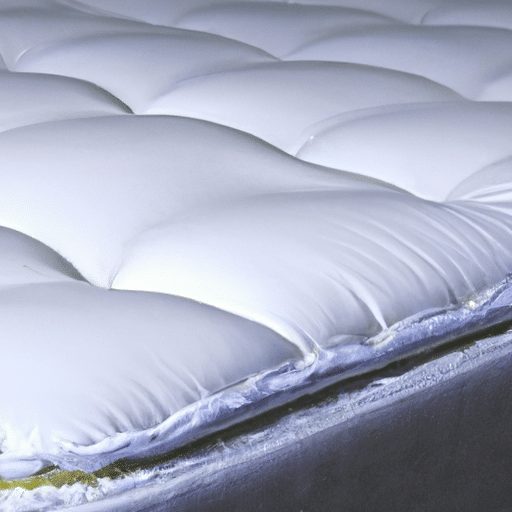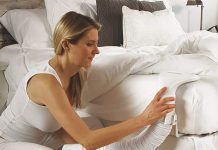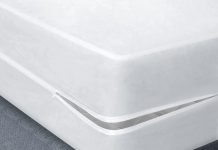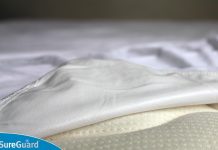Are you tired of constantly adjusting your mattress protector every time you wake up? We understand how frustrating it can be, which is why we’re here to help. In this article, we will share some simple yet effective tips on how to keep your mattress protector from shifting. Say goodbye to restless nights and say hello to a perfectly secure and comfortable mattress.
Review contents
Choose the Right Mattress Protector
Selecting the proper size of mattress protector is crucial to ensure a snug fit and prevent any shifting. It’s essential to measure your mattress accurately before purchasing a protector. Most protectors come in standard sizes such as twin, full, queen, and king. If you have an unconventional mattress size, it’s advisable to look for protectors that offer customizable options. By choosing the right size, you can ensure a secure and comfortable fit for your mattress.
Consider the type of mattress protector that suits your needs. There are different types available, such as waterproof protectors, allergen-resistant protectors, and cooling protectors. Waterproof protectors are ideal for protecting your mattress from spills, stains, and moisture. If you suffer from allergies, an allergen-resistant protector can help safeguard your mattress from dust mites and other allergens. Cooling protectors are designed to regulate temperature and provide a comfortable sleep environment. Assessing your specific requirements will help you make an informed decision when selecting the type of mattress protector that suits you best.
Look for secure attachment mechanisms in a mattress protector. Some protectors come with elasticized corners or straps to hold them securely in place. These attachment mechanisms ensure that the protector stays in position even while you toss and turn during the night. It’s essential to choose a protector with durable and high-quality attachment mechanisms to prevent any shifting or displacement.
Prepare Your Mattress
Before securing your mattress protector, it’s essential to ensure that your mattress’s surface is clean and dry. Dust, dirt, and moisture can impact the effectiveness of the protector and can also lead to unpleasant odors. Vacuum your mattress to remove any dust or dirt particles, and let it air out for a little while to ensure it is completely dry. Taking the time to clean and dry your mattress surface will create an optimal environment for securing the protector.
When placing the mattress protector on your bed, ensure that the mattress is properly centered. Aligning the mattress correctly on the bed frame will help prevent any unnecessary movement or shifting. Make sure the mattress is evenly positioned with equal spacing on both sides, top, and bottom. This simple step will contribute to a secure and stable foundation for your mattress protector.
Secure the Mattress Protector
Using fitted mattress protectors is an effective way to keep the protector in place. Fitted protectors have elasticized corners that snugly wrap around the mattress, ensuring a secure fit. When choosing a fitted protector, select one that provides a snug fit for the dimensions of your mattress. A well-fitted protector will stay in place throughout the night, providing optimal protection and comfort.
In addition to using fitted protectors, attaching the protector tightly to the mattress is essential to prevent shifting. Pull the protector taut and ensure that it is firmly anchored to the mattress on all sides. You can do this by physically pulling the protector towards the edges and tucking it in tightly. This taut attachment will minimize any movement or displacement of the protector.
Consider using additional tools such as safety pins or tape to secure the edges of the mattress protector if you find that it still shifts. Safety pins can be discreetly placed along the sides of the protector, attaching it to the mattress. Clear tape can also be used to stick the edges of the protector to the mattress, providing an extra layer of security. These additional measures can offer peace of mind and further reduce the chances of the protector shifting.
Utilize Non-Slip Material
To enhance the stability of your mattress protector, consider applying a non-slip mat or grip pad between the mattress and the protector. Non-slip mats are designed to provide friction and grip, preventing any movement or shifting. Place the mat or grip pad on top of the mattress before adding the protector. This non-slip material will help anchor the protector in place, ensuring a secure fit while you sleep.
Elastic bands or straps can also be utilized to keep the mattress protector from shifting. These bands or straps can be attached securely to the corners of the protector and wrapped around the underside of the mattress. As the bands or straps are tightened, they provide tension and secure the protector in place. This simple but effective solution can significantly reduce the chances of the protector moving around during the night.
Opt for Grippy Bed Sheets
Choosing the right bed sheets can contribute to keeping your mattress protector in place. Deep-pocket sheets are designed to fit securely around thicker mattresses, providing an extra layer of protection against shifting. This ensures that the sheets themselves do not slide or move, thus minimizing any disruption to the mattress protector.
Prefer sheets with grippy corners or fitted straps. Some bed sheets come with grippy corners that have a rubberized surface, providing additional traction when placed over a mattress protector. These grippy corners will help hold the sheets in place, reducing the likelihood of the protector shifting. Alternatively, sheets with fitted straps can be secured tightly to the mattress, creating a stable foundation for the protector.
Regularly Check and Adjust
Even with the best preventive measures in place, it’s always a good idea to inspect the mattress protector periodically for any signs of shifting. Over time, elastic and attachment mechanisms may loosen, leading to potential movement. By checking the protector regularly, you can address any issues promptly and ensure its proper positioning on the mattress. If you notice any shifting, adjust the protector accordingly to prevent further movement.
Consider Mattress Fasteners
For added security, mattress fasteners can be employed to keep the protector from shifting. Mattress suspenders are elastic bands that wrap around the corners of the mattress, holding it in place. Install the suspenders diagonally or in a crisscross pattern, providing even tension and anchoring the protector securely. Another option is to use mattress clips or buckles, which attach the edges of the mattress protector to the bed frame. These fasteners can significantly reduce any movement or shifting of the protector.
Try Anti-Slip Mattress Pads or Toppers
If you’re still struggling to keep your mattress protector in place, consider using an anti-slip mattress pad or topper. These specialized products are designed to provide additional grip and prevent any shifting of the entire mattress. Choose a non-slip mattress pad or a topper with a grip surface that will create friction between the mattress and the protector. This added layer of stability will ensure that both the mattress and the protector remain securely in position throughout the night.
Secure the Edges
To further minimize shifting, use sheet straps or suspenders to secure the edges of the mattress protector. These straps or suspenders can be attached to the corners of the protector, and then tightly fastened under the mattress. This securing method prevents any movement or displacement of the protector, ensuring that it stays in place. Additionally, remember to tuck any excess fabric tightly under the mattress, creating a neat and secure appearance.
Address a Sagging Mattress
If your mattress is already sagging or lacks support, it can contribute to the shifting of a mattress protector. To tackle this issue, consider using additional support under the mattress. Mattress boards, plywood sheets, or other supportive materials can be placed between the mattress and the bed frame to provide extra stability. By addressing the underlying sagging issue, you can help prevent any further movement of the mattress protector.
If all else fails and your mattress is old and no longer providing the necessary support, it may be a wise decision to replace it altogether. An old mattress that has lost its shape and firmness can lead to an increased likelihood of shifting, regardless of the preventive measures taken with the protector. Investing in a new mattress will not only ensure a comfortable night’s sleep but also minimize the chances of the mattress protector moving around.
In conclusion, keeping a mattress protector from shifting requires a combination of preventive measures and careful considerations. From selecting the right size and type of protector to securing it tightly and utilizing non-slip materials, each step plays a significant role in maintaining the protector’s stability. Regular checks and adjustments, as well as the use of mattress fasteners or anti-slip pads, can offer extra security. By following these guidelines and addressing any underlying mattress issues, you can enjoy a well-protected and stable sleep surface every night.































